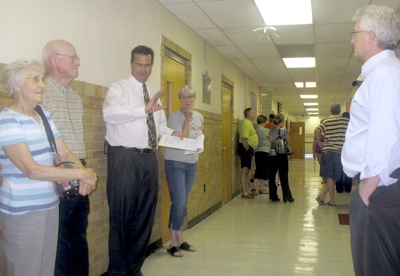Wednesday, September 14th, 2011
Four possible school choices
By Margie Wuebker

Photo by Margie Wuebker/The Daily Standard
New Bremen Junior High Principal Howard Overman, shown in the center, on Tuesday conducts a tour of the elementary/junior high building and its multiple additions ranging from 1929 to 1991. More than 150 district residents then heard a presentation on possible construction or renovation plans.
NEW BREMEN - Four options are being considered for a new K-8 school building in the village, with two utilizing Ohio School Facilities Commission (OSFC) funds.
More than 150 people toured the current New Bremen Elementary/Junior High School on Tuesday night and learned of construction plans.
Board of education members explained the four options - two propose constructing a new K-8 building near the high school with some funding from OSFC and two propose renovating the existing K-8 building on Walnut Street with no state money.
One option they are not considering is the state's recommendation to build a K-6 building at $13.6 million, with 50 percent OFSC funding. Local taxpayers would pay the remaining $6.8 million.
"There is not enough academic (classroom) space at the high school to move seventh- and eighth-graders there as the state recommends," superintendent Ann Harvey explained.
Additionally, if junior high students were moved to the high school that building would then have to meet OSFC specifications.
One plan to build a new K-8 building is pegged at $19.1 million with $6.8 million coming from the state and nearly $12.2 million paid locally.
A second plan for construction adds several upgrades, such as standing seam metal roofing, terrazzo flooring and advanced technology. The total cost increases to $20.2 million with $6.8 million funded by the state and $13.3 million from local millage. The figure also includes construction of a connector to link the K-8 building to the high school.
Costs for the two plans to renovate the existing building range from $12.5 million to just over $16 million. All funding would come from local taxpayers.
Architect John Freytag said enough land is at the high school site to accommodate a new elementary/junior high. Board members have not identified the exact location, but it likely will be a multi-story structure.
A new building would encompass 80,540 square feet while the existing facility has 115,000 square feet. An independent assessment completed in 2007 and updated this year cited the need for 55,614 square feet based on enrollment. The additional space involves a larger gym as well as larger classrooms to accommodate science labs and other academic areas.
Treasurer Deb Meyer said the county auditor is estimating 7.5 mills will be needed for a local tax issue when using an average of all building options. If approved, the issue would run for 38 years.
In 1996, voters approved an 8.86-mill levy to build the high school, which did not use OSFC funding. That issue expires in December 2018.
Board president Keith Bornhorst said the time frame on the issue is longer to keep the millage down. School districts are now permitted up to 40 years.
Another bond issue, which began in 1991 to build an addition to the elementary/junior high building, expires in December 2013.
Passage of 7.5 mills would cost the owner of a $100,000 home an additional $229.69 per year. The board has talked about putting a measure on the ballot as early as a February special election. If passed, students could be in new classrooms in about three years, board members said.
Meyer explained the millage figure includes a mandatory five-tenths mill for maintenance and repair. She anticipates operating costs to go down in a new energy-efficient building even with the addition of air conditioning.
Board members have not yet decided what would happen to the former building if a new one were built. The OSFC would fund 50 percent of the cost of demolition. Any work related to "buttoning up" whatever is saved would be paid with local tax dollars.
Bornhorst admitted Tuesday's tour took participants to the worst areas of the building, including the boiler room where two vintage 1929 boilers remain for use as backup or for spare parts.
"Doing nothing and taking a Band-aid approach is not really an option," he said. "The time to do something is here."
Attendees were asked to fill out a sheet ranking the options and some opted to take the papers home. The results will be tabulated and assist the board in making its decision.
The board meets in special session at 7:30 p.m. Sept. 21 at the high school community room.



